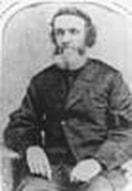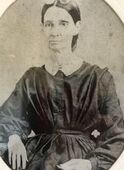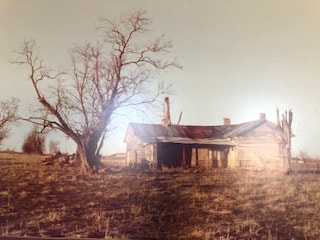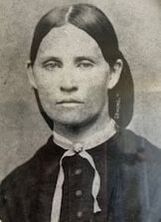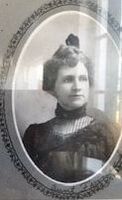John Polk (1804-1852) and Louisa Campbell (1810-1866)
Considered the founder of Springfield, MO, John Polk Campbell was born in Mecklenburg, NC and later moved to Maury County, Tennessee. He and his brother Madison came to this area in the 1829. The story is recorded by Louisa Cheairs McKenny Sheppard, granddaughter of John Polk Campbell in her journal which was compiled in the book A Confederate Girlhood.
“On their outward trip, the two brothers lost their way and when night fell they had no idea where they were; but as they were stumbling on in the darkness, seeking a suitable camping place, they happened on an Indian village where they were received with grave kindness. It soon transpired that one of the young Indians was very ill. An old chief led the two white boys to the tepee where the sick lad lay and made them understand that they were to cure him. With all the assurance of youth, they undertook the task, using the medical supplies and herbs provided by their mother for their trip.”
The story continues to say that in return for helping the young man to recover, the Kickapoo Chieftain rewarded John with a plot of land containing a spring. This land later became the beginning of Springfield, MO.
 Louisa Terrell Cheaires Campbell
Louisa Terrell Cheaires Campbell
In a publication entitled, "History and Directory of Springfield and North Springfield", compiled and published by George S. Escott, it is written that this land containing the Fulbright Spring and a natural well is were John P Campbell carved his initials in a tree marking his land. He returned to Tennessee for his wife and daughter and headed back to the Kickapoo Prairie in 1830. Mr. Campbell's family traveled with his brother-in-laws family and six slaves. They returned to find that Billy Fulbright and his brother John Fulbright had already begun building cabins on this land. Since John had a longer standing claim, proven by his initials in the tree, the land and cabins were forfeited to him. His original land claim, recorded April 10, 1843, is bounded approximately by the modern streets of Mill Street on the north, Holland Avenue on the east, Cherry Street on the south, and Campbell Avenue on the west. He later donated 50 acres to become the beginning of their new town. Springfield was incorporated in 1838 with a then population of 500 residence living there.
According to his daughter, Sarah, John left his home at the age of thirteen to be educated in Mecklenburg, NC. While attending school he lived for a short time with descendants of Gen. Nathanael Greene. In 1833 Greene County was established and John was responsible for the county being named after the admired general. John P Campbell became the first county clerk and his home served as the first county court house. John donated land for the forming of Springfield and helped to design the layout of the town. John and his wife, Louisa (1810-1866) had ten children who lived to adulthood. Their children were: Tabitha Caroline, Mary Frances, John Nathaniel, Leonidas Adolphus, Sarah Rush, James Cheaires, Thomas Polk, Samuel Independence, Constantine and William Argyll. Three other sons, Jack, Thomas and Rush died in infancy. Their second child Mary Frances born in 1831, was the first white female born in the area. While we have no photos of him, John was described as having light brown curly hair and a fair complexion. His 6 foot 2 inch frame towered over others. Louisa is described as also remarkably tall with dark hair and fine eyes.
After establishing Springfield, John explored new territories in Texas and present day Oklahoma. He died in 1852 in Oil Springs, Cherokee Nation.
The remaining Campbell families lived in Springfield until the onset of the Civil War. Being slave owners and southern sympathizers they were supporters of the Confederacy. Once Springfield was secured by Union forces the Campbells were forced to move their families to Mississippi and Tennessee. Four of the Campbell's sons fought in the Civil War with two of them, Thomas P. and John N. dying as a result. Leonidas and Samuel survived. Louisa and Sarah Rush returned to Springfield with hopes of restoring their family home. Louisa died in 1866.
According to his daughter, Sarah, John left his home at the age of thirteen to be educated in Mecklenburg, NC. While attending school he lived for a short time with descendants of Gen. Nathanael Greene. In 1833 Greene County was established and John was responsible for the county being named after the admired general. John P Campbell became the first county clerk and his home served as the first county court house. John donated land for the forming of Springfield and helped to design the layout of the town. John and his wife, Louisa (1810-1866) had ten children who lived to adulthood. Their children were: Tabitha Caroline, Mary Frances, John Nathaniel, Leonidas Adolphus, Sarah Rush, James Cheaires, Thomas Polk, Samuel Independence, Constantine and William Argyll. Three other sons, Jack, Thomas and Rush died in infancy. Their second child Mary Frances born in 1831, was the first white female born in the area. While we have no photos of him, John was described as having light brown curly hair and a fair complexion. His 6 foot 2 inch frame towered over others. Louisa is described as also remarkably tall with dark hair and fine eyes.
After establishing Springfield, John explored new territories in Texas and present day Oklahoma. He died in 1852 in Oil Springs, Cherokee Nation.
The remaining Campbell families lived in Springfield until the onset of the Civil War. Being slave owners and southern sympathizers they were supporters of the Confederacy. Once Springfield was secured by Union forces the Campbells were forced to move their families to Mississippi and Tennessee. Four of the Campbell's sons fought in the Civil War with two of them, Thomas P. and John N. dying as a result. Leonidas and Samuel survived. Louisa and Sarah Rush returned to Springfield with hopes of restoring their family home. Louisa died in 1866.
Elijah (1799-1882) and Anna Brooks (1804-1878) Gray
Elijah and Anna Gray were originally from Virginia. They were both educated in the early schools of Virginia and married in 1823. They moved from Virginia to Tennessee and later to Springfield, MO. It is thought that Elijah was encouraged by his friend, John Polk Campbell to move his family to this region. With two older brothers, Elijah was unlikely to inherit any of the family farm, so moving to Missouri where land was cheap and settled by other Tennesseans seemed like a good idea. So, after visiting the area in 1840, Elijah sold his stakes in Tennessee, packed up his family and 10 slaves and made the quest to Greene County. He purchased 400 acres, built a home and began farming. As a farmer, he was awarded the prize for one of the three best exhibitors of corn during the 1860 Southwest Missouri District Fair. His land as divided into two tracts, one of 240 acres and one of 160 acres in the Wilson Township. While many houses of this time were log cabins, the Grays built a fine home of hewn logs, covered with a shingled roof and topped with a stone chimney. The couple had four children including, one son- James Price, three daughters- Louisa (married Lee Yarbrough 1843), Mary (Polly) Ann (married John Weaver), and Susan Elizabeth. Susan who was two years old when they moved to Missouri. She was educated in Springfield and later married John Polk Campbell in 1857. The 1850 census records show 14 people living on the farmstead. With the older daughters married the residents were Elijah, Annie, James and Susan living in the home. Records show there were 10 slaves living on the property, only identified by age and sex. There were three males 18, 26, and 33 years of age and three women all aged 25 and four small children.
Not only was Elijah noted as a leader in farming but also in business. He was elected as a director of the Springfield Bank. Elijah was also very active in local, state and national politics. Leading up to the Civil War many Missourians were at odds when it came to the extension of slavery. In the 1850's Elijah, a slave owner himself was associated with the Missouri Bentonites (in favor of Thomas Hart Benton) of the Democratic Party. It is not known how Elijah's views and support of candidates opposing the extension of slavery may have influenced the treatment or emancipation of Elijah's slaves. In 1861, a group of Unionists men met to discuss the position of Greene County. While it is not know for sure if Elijah attended the meeting, it was attended by many of his associates.
Annie gray died in 1878. Elijah died in 1882 from a broken hip as a result of a horseback riding incident. Both he and Annie were buried in the Yarbrough Cemetery located near their farmstead.
Not only was Elijah noted as a leader in farming but also in business. He was elected as a director of the Springfield Bank. Elijah was also very active in local, state and national politics. Leading up to the Civil War many Missourians were at odds when it came to the extension of slavery. In the 1850's Elijah, a slave owner himself was associated with the Missouri Bentonites (in favor of Thomas Hart Benton) of the Democratic Party. It is not known how Elijah's views and support of candidates opposing the extension of slavery may have influenced the treatment or emancipation of Elijah's slaves. In 1861, a group of Unionists men met to discuss the position of Greene County. While it is not know for sure if Elijah attended the meeting, it was attended by many of his associates.
Annie gray died in 1878. Elijah died in 1882 from a broken hip as a result of a horseback riding incident. Both he and Annie were buried in the Yarbrough Cemetery located near their farmstead.
James Price (1832-1887) and Sallie Gilmore (1891-1920) Gray
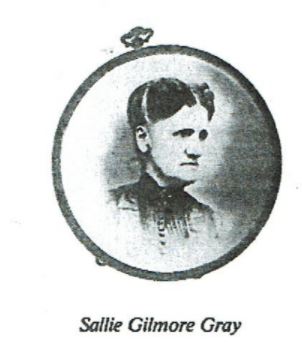
Son of Elijah Gray and Annie Brooks Gray, James Price Gray moved to Springfield, MO in 1840. James was one of four siblings including, Mary Ann (Polly) (married John R. Weaver) , Louisa (married Lee Yarbrough 1843), and Susan Elizabeth. His sister Susan married John Polk Campbell who was the nephew of the founder of Springfield. In 1841 the family purchased the 400 acre farmstead, that was divided into two tracts. The larger 240 acre tract would be his parent's farmstead. The second tract of 160 acres was where, in 1856, James built the home now standing on the Gray/Campbell Farmstead. His new home would be of similar architecture as his family home just down the road a piece. He also married Mary Blakey in 1856, but she died the following year, possibly during childbirth. Her death left James a widow with sickly infant son. The son only survived a few years. In 1859 he remarried Sallie Gilmore. They had six children including Susie (born a few months and within miles of the Battle at Wilson's Creek 1861), Anna (born near the time and place of the Battle of Springfield, 1863), Lucy, Maggi, Fanny and Charles. Raising a family in the midst of the Civil War was very difficult. There is no record of James having any military service during the Civil War. Even though he grew up with many Confederate sympathizers including his wife's family, it is likely he shared the same sentiments as his father.
In 1861 James entered a business deal with Jabez Owen. While the nature of the endeavor is not documented, it is recorded that the two men incurred a large debt. Unable to repay the debt, the house and property were put on the auction block. The home was purchased by John R. Weaver (James's brother-in-law). It is believed that James, Sallie and their family remained living in the home.
After losing his home at auction, James Gray moved to Montgomery County, Missouri in 1864. Sometime the next year James and Sallie moved in with his parents and remained there for the next 18 years. In 1883, James became ill and moved his family into town. He died in 1887 from cancer. Sallie and her daughters operated boarding houses for the next several years. Sallie died in 1920.
In 1861 James entered a business deal with Jabez Owen. While the nature of the endeavor is not documented, it is recorded that the two men incurred a large debt. Unable to repay the debt, the house and property were put on the auction block. The home was purchased by John R. Weaver (James's brother-in-law). It is believed that James, Sallie and their family remained living in the home.
After losing his home at auction, James Gray moved to Montgomery County, Missouri in 1864. Sometime the next year James and Sallie moved in with his parents and remained there for the next 18 years. In 1883, James became ill and moved his family into town. He died in 1887 from cancer. Sallie and her daughters operated boarding houses for the next several years. Sallie died in 1920.
Junius T. (1812-1877 ) and Mary A. Blackwell (1814-1893) Campbell
Junius T. Campbell, from Tennessee, moved to Springfield, MO in 1831. He started his eight year business by opening the first mercantile for the town. The opening of this store was also the beginning of commerce for the little log cabin community. It wasn't long before more stores, mills, a school, a post office and other businesses started operation. In 1832, the community celebrated one of the first wedding ceremonies when Junius married Mary A. Blackwell. The two were parents of 14 children including John P. Campbell, former owner of the house at the Gray/Campbell farmstead.
Mr. Campbell held many prominent positions in Springfield. Between 1836-1855 he was the Justice of the Peace (although only worked one case before resigning), County Treasurer, Postmaster, and County Sheriff. In 1876, Junius was the president of the Old Settlers' Association.
Mr. Campbell held many prominent positions in Springfield. Between 1836-1855 he was the Justice of the Peace (although only worked one case before resigning), County Treasurer, Postmaster, and County Sheriff. In 1876, Junius was the president of the Old Settlers' Association.
John R. (1819-1899)and Mary Ann Gray(1827-1890) Weaver

John R. Weaver son of John (Jockey) Weaver and Barbara Richards Weaver grew up in what is present day Christian County, MO. In 1846 he married Mary Ann (Polly) Gray. They had six children. John R. owned property along the Finley River and along with his brother-on-law owned the mill on the river. In 1863 John purchased the home and property of his brother-in-law, John P. Campbell (house now located at the Gray/Campbell Farmstead), when it was sold at auction. It is believed John Campbell and his wife Sallie remained living in the residence.
John Polk (1835-1878) and Susan E. (1837-1923) Campbell
One of eleven children of Junius Tennessee Campbell and Mary A. Blackwell Campbell. John P Campbell was born in Springfield, MO in 1835. While he attended school in Springfield and later in Fayetteville, MO, however most of his education came from learning to clear and farm the land with his father. John was the nephew and namesake of the founder of Springfield, MO. John married Susan Elizabeth Gray in 1857. They had ten children including, Mary Frances, Richard Huntley, John P. Jr., Junius E., Robert Bruce and Russell Vinton. John purchased the home belonging his brother-in-law James P. Gray. He began successful farming there until his death in 1878. John's daughter Mary Frances married Charles W. Doling another prominent Springfield citizen with who's family Doling Park is named.
Sarah Rush Campbell Owen (1837-1925)
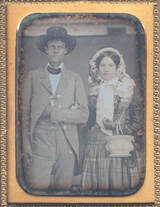 Leonidas and Sarah
Leonidas and Sarah
Sarah Rush was the seventh child of John Polk Campbell and Louisa Terrell Cheaires Campbell. She married Jabez Owen (1831-1862) in March of 1855. She and Jabez lived in Texas in 1861 at the onset of the Civil War. She returned to Greene County, MO as a widow in 1869 and stayed until her death in 1925. Sarah and Jabez had at least four children, two girls and two boys.
Pictured to the right is Sarah and her brother Leonidas A. Campbell. Leonidas fought for the Confederacy during the Civil War.
Pictured to the right is Sarah and her brother Leonidas A. Campbell. Leonidas fought for the Confederacy during the Civil War.
